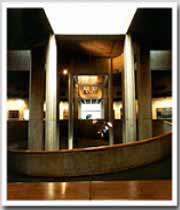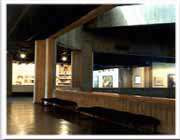Tehran Museum of Contemporary Art
Tehran Museum of Contemporary Art is surrounded by 7000 sq/m of landscape, known as the sculpture park, in which sculptures by renowned international and Iranian artists are on display. The museum building, with 5000 sq/m gross area, was designed by the architect Kamran Diba, and was inaugurated in 1977.
As a contemporary example of Iranian architecture, its design has been inspired by certain traditional Iranian as well as modern architecture. The building is sited adjacent to Kargar avenue, from which visitors access the main entrance. On the approach towards the main entrance, four semi-arch vertical elements are seen atop the building at a distance. These elements, which function as skylights above the atrium inside, are metaphorical gestures of traditional wind-catchers in some provincial towns bordering the desert of central Iran.
Similar semi-arched skylights are utilized, either linearly or fragmented, above the galleries throughout the building.
Collectively, these spread out parallel skylights mounted atop the single story rectangular masses of the galleries, constitute the main formal language of this angularly set complex. It is a concrete frame building with non-geometric rough stone finish on the exterior, and the roof's skylights are covered with seamed copper panels.
The first gallery, called Chahar-su (four-way), surrounds the spacious atrium, and accommodates direct access to the exterior sculpture court, coffee shop, book shop, second gallery.
and the central ramp which circularly descends one floor, under the four skylights, providing further access along its course to the library, administrative and curatorial offices. From the second gallery, on the ground floor, the visitors follow a rather long descending path, which leads to the seven remaining galleries, terminating in the ninth gallery located at a close proximity from the bottom of ascending central ramp and the atrium.
Here, at the center of this solemn atrium, a rectangular pool, inspired by the concept of "hoze" (small pool) in Iranian architecture, is placed. It has filled the heart of the museum with a mysterious haze of artistic sense and charm.
Museum Administration
The day to day running of the Tehran Museum of Contemporary Art is divided into four sections: the Department of Administrative Affairs, which coordinates the activities of the entire museum; the Department of Artistic Affairs, which curates and organizes exhibitions; the Office of Guides and Guards, which trains guides to provide informative tours of the museum in several languages for visitors, and trains the guards to protect the museum's property; and the Department of Public Relations, which liaises with international art institutions and maintains contact with artists and the general public. An important aspect of this department's duties is the analysis and classification of data relating to artists and works of art for our computer-based art information bank.


Another essential museum department is Exhibition Services and Art Archives where paintings from the museum's permanent collection are stored. The archives fill three halls with a stable temperature of 22c, in which the art works are stored on mobile metal mesh sheets fitted on to ceiling tracks.
The Department of Photography is a well-equipped department which provides several services, including photographing museum events and the museum's collection, as well as maintaining the museum's photographic archive.
The Library
The Library holds several thousand books and journals on various fields of art in many languages.
As a specialized library, it is only open to members, as well as researchers, scholars and students.
The Art Galleries
The Museum of Contemporary Art has nine galleries, three of which are dedicated to paintings by international artists from the museum's permanent collection. Temporary exhibitions are held in the other six galleries throughout the year.
Sculpture Court
The Sculpture Court is a semi-enclosed exterior space within the museum complex.It is an appropriate setting for the sculptural works of three outstanding artists:
"Le Therapeute" by Rene Magritte, "A Man and a Woman" by Alberto Giacometti, and "Horse and Rider" by Marino Marini.
Sculpture Park
Most of the sculpture park's grounds are located to the north of the museum complex. The Park is home to works by a number of the world's leading sculptors, including "Capricorn" by Max Ernst; "The Prickly Pear" by Alexander Calder; "The Reclining Figure" by "Henry Moore"; "Homage to Pablo Neruda" by Eduardo Chilida; "Multiplied by Space" by Max Bill; and "Shirin and Farhad" by Parviz Tanavoli, amongst others.
Cinemateque
The cinemateque takes advantage of the museum's theatre for actively pursuing its main objectives, which include the introduction, presentation and revaluation of the significant works in the history of world cinema. Its programs are in the following categories:
Cinema and visual arts
Iranian cinema
Contemporary world cinema
Avant-garde cinema
Movie directors
Documentary and short movies